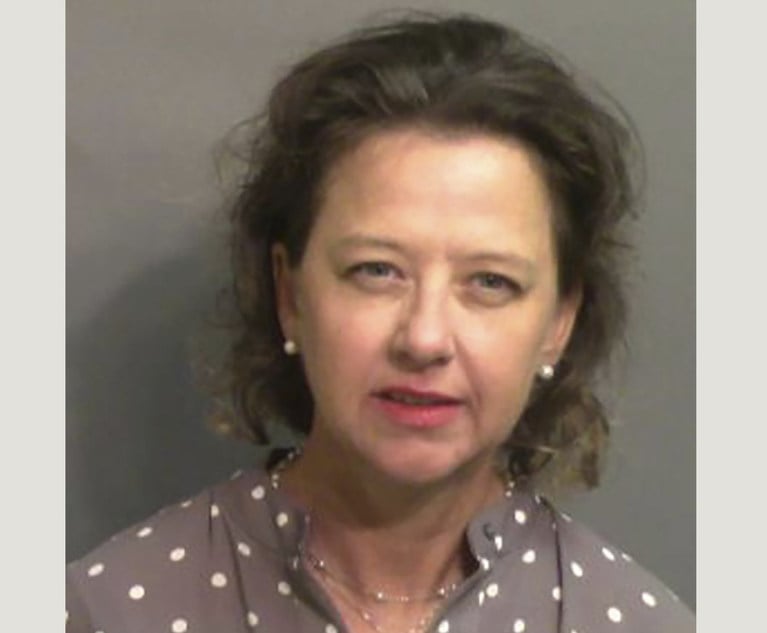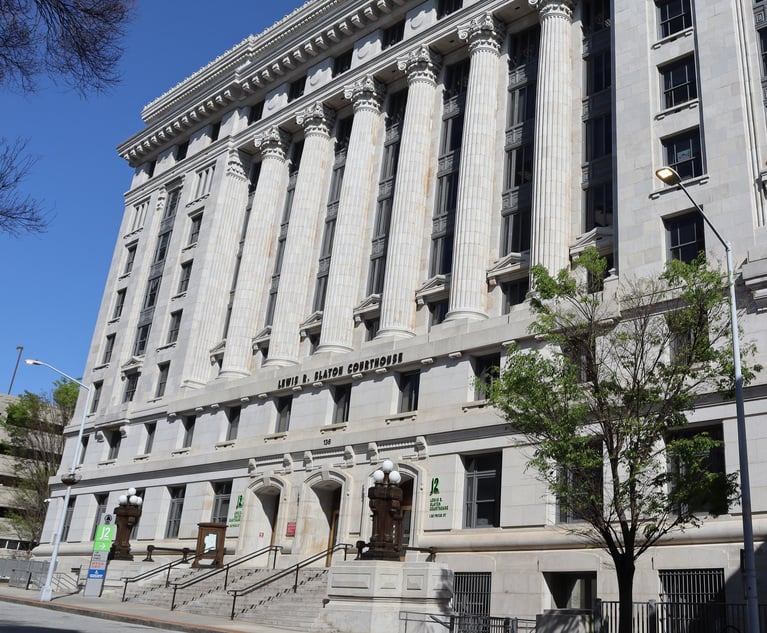New DNA Forensic Science Comes Under Scrutiny at GSU Law Symposium
A panel at Georgia State University Law discussed the potential and limitations of current computing methods in DNA forensics.
April 11, 2018 at 11:42 AM
5 minute read
The original version of this story was published on Legal Tech News
 |
|
Forensic science, like many other fields, is beginning to see the potential impact of computer processing on its standard methodologies. But questions loom about the viability and strength of these methods in making finite determinations, especially when the freedom of criminal defendants is on the line.
Speakers at Friday's 2018 Georgia State Law Review Symposium, titled “From the Crime Scene to the Courtroom: The Future of Forensic Science Reform,” sought to address some of the ways in which technological advances have helped debunk old forensic science and created new challenges for criminal lawyers. One of the symposium's panels, “Technological Advancements in Forensic Science,” considered the potential benefits and ongoing concerns around applying advanced computing methods to DNA forensics used in criminal evidence.
Panel moderator and GSU College of Law associate dean Jessica Gabel Cino framed the discussion by poking some holes in the perceived accuracy of DNA testing, a scientific method that has cleared the names of a number of wrongfully convicted individuals. “DNA is seen as that gold standard that tends to equalize things,” she said. “It's not necessarily that straightforward. It can be very complex when you're talking about, for example, mixture cases,” where multiple people's genetic material is represented in the same DNA sample.
New forensic technology, she noted, attempts to use algorithms to bring clarity to those mixture cases. Companies touting software solutions to these problems—such as TrueAllele Casework, which has software slated to be adopted by the Georgia Bureau of Investigation—often do not disclose their algorithms, making it difficult for attorneys to interrogate their methods.
Clint Hughes, senior staff attorney at the Legal Aid Society of New York City, worked on a few cases where software from companies like TrueAllele and STRmix have produced some discordant results from one another. While he found that the software does seem to have a good track record in deducing variation in DNA, there can certainly be reason to interrogate their methodology and results.
“These kinds of software are more acceptable to the experts that we used because they take the peak heights into account, and they take other kinds of modeling into account, but that does not mean that they are necessarily offering accurate results,” Hughes said.
Forensic Bioinformatic Services systems engineer Nathan Adams noted that, while previous forensic science attempted to simply identify the presence of a particular person in a DNA sample, current technology is looking instead to identify where and how much of a person is represented in those samples. “We're moving in a direction of more discriminatory power with these more complex programs,” he said.
While there is some published research and source code available, these methods are typically proprietary, making it tough for attorneys to tell exactly how these methodologies are being applied. “We don't necessarily know what's going on behind the scenes,” Adams said.
ACLU legal fellow Vera Eidelman urged audience members to consider what incentive structures make it difficult for attorneys to gain access to the information they might want or need about these algorithmic methods. “These are proprietary algorithms that are being put out by private companies that are attempting to make a profit, and are now claiming private property interests. They're claiming that the underlying algorithms are trade secrets,” she said.
“There are just more barriers to finding out all of the important things that have been discovered for other types of forensic science that we've been hearing about throughout the day,” Eidelman said, nodding to the previous panels' discussions of now-discredited methods of attribution.
South Dakota State University math and statistics professor Cedric Neumann acknowledged that the science used by companies like TrueAllele and STRmix has been published and peer reviewed. However, attorneys are faced with attempting to deduce whether the software applies this science appropriately and whether the software has applied to the particular sample effectively.
Chuck Boring, Cobb County deputy chief assistant district attorney, said jurors are fairly wary of being duped by supposedly complex technology. “You have to be upfront about the limitations,” he said.
However, acknowledging the limitations of the science to jurors may mean that prosecutors can't hinge their case on this method alone. “It may be more useful to use it as corroboration,” Boring said.
Although these new potential uses of computing and algorithmic learning have great potential to shift forensic science, Adams said scientists still have quite a way to go before these methods can be really made indisputable. “We've started to talk about it,” Adams said, “But we're nowhere near what I would consider to be a mature state of having fully incorporated computing as a relevant discipline that we need to cross-train on.”
This content has been archived. It is available through our partners, LexisNexis® and Bloomberg Law.
To view this content, please continue to their sites.
Not a Lexis Subscriber?
Subscribe Now
Not a Bloomberg Law Subscriber?
Subscribe Now
NOT FOR REPRINT
© 2024 ALM Global, LLC, All Rights Reserved. Request academic re-use from www.copyright.com. All other uses, submit a request to [email protected]. For more information visit Asset & Logo Licensing.
You Might Like
View All
Trump Election-Interference Prosecution Appears on Course to Wind Down
4 minute read
Judge Sets Early 2025 Trial for Ex-Prosecutor Charged With Meddling in Ahmaud Arbery Investigation
3 minute read
Rapper Young Thug Is a Free Man. Here Are Things to Know About His Plea.
8 minute read
Trending Stories
- 1Decision of the Day: School District's Probe Was a 'Sham'; Title IX Administrator Showed Sex-Based Bias
- 2US Magistrate Judge Embry Kidd Confirmed to 11th Circuit
- 3Shaq Signs $11 Million Settlement to Resolve Astrals Investor Claims
- 4McCormick Consolidates Two Tesla Chancery Cases
- 5Amazon, SpaceX Press Constitutional Challenges to NLRB at 5th Circuit
Who Got The Work
Michael G. Bongiorno, Andrew Scott Dulberg and Elizabeth E. Driscoll from Wilmer Cutler Pickering Hale and Dorr have stepped in to represent Symbotic Inc., an A.I.-enabled technology platform that focuses on increasing supply chain efficiency, and other defendants in a pending shareholder derivative lawsuit. The case, filed Oct. 2 in Massachusetts District Court by the Brown Law Firm on behalf of Stephen Austen, accuses certain officers and directors of misleading investors in regard to Symbotic's potential for margin growth by failing to disclose that the company was not equipped to timely deploy its systems or manage expenses through project delays. The case, assigned to U.S. District Judge Nathaniel M. Gorton, is 1:24-cv-12522, Austen v. Cohen et al.
Who Got The Work
Edmund Polubinski and Marie Killmond of Davis Polk & Wardwell have entered appearances for data platform software development company MongoDB and other defendants in a pending shareholder derivative lawsuit. The action, filed Oct. 7 in New York Southern District Court by the Brown Law Firm, accuses the company's directors and/or officers of falsely expressing confidence in the company’s restructuring of its sales incentive plan and downplaying the severity of decreases in its upfront commitments. The case is 1:24-cv-07594, Roy v. Ittycheria et al.
Who Got The Work
Amy O. Bruchs and Kurt F. Ellison of Michael Best & Friedrich have entered appearances for Epic Systems Corp. in a pending employment discrimination lawsuit. The suit was filed Sept. 7 in Wisconsin Western District Court by Levine Eisberner LLC and Siri & Glimstad on behalf of a project manager who claims that he was wrongfully terminated after applying for a religious exemption to the defendant's COVID-19 vaccine mandate. The case, assigned to U.S. Magistrate Judge Anita Marie Boor, is 3:24-cv-00630, Secker, Nathan v. Epic Systems Corporation.
Who Got The Work
David X. Sullivan, Thomas J. Finn and Gregory A. Hall from McCarter & English have entered appearances for Sunrun Installation Services in a pending civil rights lawsuit. The complaint was filed Sept. 4 in Connecticut District Court by attorney Robert M. Berke on behalf of former employee George Edward Steins, who was arrested and charged with employing an unregistered home improvement salesperson. The complaint alleges that had Sunrun informed the Connecticut Department of Consumer Protection that the plaintiff's employment had ended in 2017 and that he no longer held Sunrun's home improvement contractor license, he would not have been hit with charges, which were dismissed in May 2024. The case, assigned to U.S. District Judge Jeffrey A. Meyer, is 3:24-cv-01423, Steins v. Sunrun, Inc. et al.
Who Got The Work
Greenberg Traurig shareholder Joshua L. Raskin has entered an appearance for boohoo.com UK Ltd. in a pending patent infringement lawsuit. The suit, filed Sept. 3 in Texas Eastern District Court by Rozier Hardt McDonough on behalf of Alto Dynamics, asserts five patents related to an online shopping platform. The case, assigned to U.S. District Judge Rodney Gilstrap, is 2:24-cv-00719, Alto Dynamics, LLC v. boohoo.com UK Limited.
Featured Firms
Law Offices of Gary Martin Hays & Associates, P.C.
(470) 294-1674
Law Offices of Mark E. Salomone
(857) 444-6468
Smith & Hassler
(713) 739-1250






